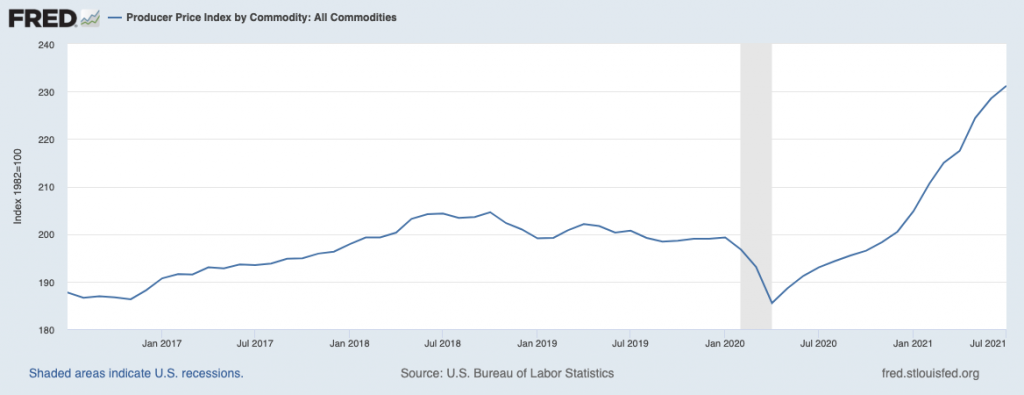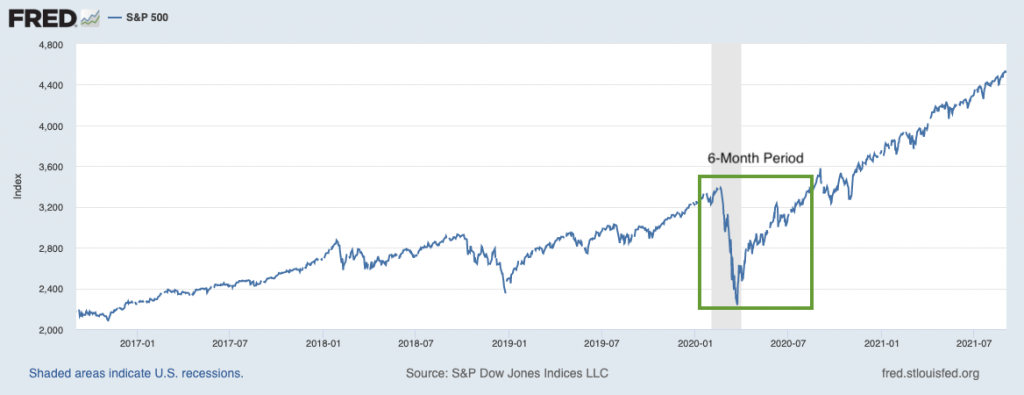As we fast approach the end of 2021, I’ve been taking time to reflect on some of the lessons I’ve learned over the past year. In 20 months or so, the world has undergone a slew of rapid-fire changes, and it has resulted in significant – and I would argue, lasting – shifts in the way we work, how we live, and how we interact. I think this period in history will be remembered for how it catalyzed many of these changes.
With that in mind, I’d like to use this week’s column to memorialize four big takeaways I’ve had since the beginning of 2020.
Lesson #1: The Challenges of Global Synchronized Reopening
When the global economy shut down for weeks in the spring of 2020, the effects were largely obvious to most market-watchers – a sharp recession was inevitable. What many economists did not fully anticipate, however, was how challenging a globally synchronized reopening would be.
To this day, a semiconductor shortage continues to stall auto production, with orders backing up six months in some cases. I’ve written many times about supply chain entanglements, which have sources in many places – from factories in Malaysia to ports in Los Angeles. To boot, many service sector businesses are having difficulty finding workers, which only adds to delays and price pressures.
__________________________________________________________________________
Are You Prepared For Any Future Market Changes?
The first half of the year brought many challenges, but also lessons to investors. For those who are looking for a long-term financial outcome, are you prepared for continued changes ahead?
I want to remind you about the importance of keeping an eye on economic indicators as opposed to timing the market. This may be difficult to do especially in times like these, but that’s where we can help!
In our just-released Stock Market Outlook report, we provide insight on how to focus on the facts and hard data. This report contains some of our key forecasts to consider such as:
- Zacks rank S&P 500 sector picks
- Zacks view on equity markets
- What produces 2021 optimism?
- Zacks forecasts for the remainder of the year
- Zacks ranks industry tables
- Sell-side and buy-side consensus
- And much more
If you have $500,000 or more to invest and want to learn more about these forecasts, click on the link below to get your free report today!
IT’S FREE. Download the Just-Released September 2021 Stock Market Outlook1
__________________________________________________________________________
Perhaps the most visible and tangible effects of the globally synchronized reopening have been in commodity prices, which many readers know has hit everything from nickel to copper, to lumber and aluminum. All told, the producer price index for all commodities has soared past pre-pandemic levels – a trend that is squeezing profit margins for producers and resulting in higher costs for consumers.

I continue to believe the current imbalances in the global economy – where demand firmly outweighs supply – is a temporary issue that will resolve itself in time. But truth be told, it’s taking longer than I expected.
Lesson #2: Hybrid Work is Here to Stay
I would argue that the ‘old normal’ of commuting to the office five days a week was slowly, but surely, changing even before the pandemic hit. Many large companies offered ‘work from home’ days and exceptions could be made for employees who needed to work remotely for special situations. A hybrid work model was developing – but the pandemic catalyzed it into being the new normal.
Studies are starting to emerge that may help corporations navigate the issue. A recent study of 30,000 U.S. workers found that working from home around one day a week would boost productivity by 4.8%, with a significant part of the one-off increase coming from reduced commuting time. The relief of not having to go to the office may also provide a boost of happiness and energy to more vigorously and creatively work on the day’s tasks.
Another study from the University of Chicago’s Michael Gibbs, however, found that workers at home were more susceptible to domestic distractions like childcare and errands, and the report also noted that people working from home may exaggerate productivity in an effort to maintain the privilege.3
The hybrid model appears to be the happy medium, and corporations will likely spend the next few years gathering data on how to best structure the new approach. For a company like Google, for example, the early idea is to have employees in the office three days a week, with the ability to spend two days “wherever employees work best.”
Lesson #3: Remember How Fast the Market and Economy Can Move
A few months ago, the Bureau of Economic Analysis officially confirmed that the 2020 pandemic-induced recession ended in April 2020. Since the recession started in February of that year, it meant the economic downturn lasted all of two months. As it were, when the recession was officially declared in June 2020, it was already over!
The stock market also moved with extraordinary quickness. Before most people even had time to wrap their heads around what the pandemic even was, and what it would mean for the future, the stock market had already posted a bear market and a v-shaped recovery. In six months, the market priced in the recession and the economic recovery that followed.

I have written before that event-driven recessions and bear markets tend to be sharper on the downside and shorter in duration than cyclical or structural recessions. But the Covid-19 recession and bear happened with unparalleled speed, and I think it’s fair to say that any investor who tried to time it likely got it wrong. To me, this is a good reminder that the economy and markets often work faster than many expect, and trying to time investment decisions over such short horizons can be a flawed approach.
Bottom Line for Investors
The global pandemic is far from over, and the U.S. economy is far from running smoothly again. But I think the three lessons detailed above will be lasting takeaways from this period of economic history – they are observations we can remember and learn from, and perhaps apply in the future to understand change while avoiding mistakes.
In addition to these lessons, we also recommend staying focused on long-term financial success. Keeping an eye on economic indicators and hard data that can positively impact your investments is a good start. Our Just-Released September 2021 Stock Market Outlook Report7, will give insight on how to do this!
This report is packed with newly revised predictions that can help you base your next investment move on hard data. For example, you’ll discover Zacks’ view on:
- Zacks rank S&P 500 sector picks
- Zacks view on equity markets
- What produces 2021 optimism?
- Zacks forecasts for the remainder of the year
- Zacks ranks industry tables
- Sell-side and buy-side consensus
- And much more
If you have $500,000 or more to invest and want to learn more about these forecasts, click on the link below to get your free report today!
Disclosure
2 Fred Economic Data. August 12, 2021. https://fred.stlouisfed.org/series/PPIACO
3 Bloomberg. August 25, 2021. https://www.bloomberg.com/news/features/2021-08-26/will-remote-work-become-the-norm-hybrid-offices-are-transforming-economies#:~:text=Working%20from%20home%20around%20one,Aut%C3%B3nomo%20de%20M%C3%A9xico%20and%20others
4 Fred Economic Data. September 9, 2021. https://fred.stlouisfed.org/series/SP500
5 Zacks Investment Management reserves the right to amend the terms or rescind the free Stock Market Outlook offer at any time and for any reason at its discretion.
DISCLOSURE
Past performance is no guarantee of future results. Inherent in any investment is the potential for loss.
Zacks Investment Management, Inc. is a wholly-owned subsidiary of Zacks Investment Research. Zacks Investment Management is an independent Registered Investment Advisory firm and acts as an investment manager for individuals and institutions. Zacks Investment Research is a provider of earnings data and other financial data to institutions and to individuals.
This material is being provided for informational purposes only and nothing herein constitutes investment, legal, accounting or tax advice, or a recommendation to buy, sell or hold a security. Do not act or rely upon the information and advice given in this publication without seeking the services of competent and professional legal, tax, or accounting counsel. Publication and distribution of this article is not intended to create, and the information contained herein does not constitute, an attorney-client relationship. No recommendation or advice is being given as to whether any investment or strategy is suitable for a particular investor. It should not be assumed that any investments in securities, companies, sectors or markets identified and described were or will be profitable. All information is current as of the date of herein and is subject to change without notice. Any views or opinions expressed may not reflect those of the firm as a whole.
Any projections, targets, or estimates in this report are forward looking statements and are based on the firm’s research, analysis, and assumptions. Due to rapidly changing market conditions and the complexity of investment decisions, supplemental information and other sources may be required to make informed investment decisions based on your individual investment objectives and suitability specifications. All expressions of opinions are subject to change without notice. Clients should seek financial advice regarding the appropriateness of investing in any security or investment strategy discussed in this presentation.
Certain economic and market information contained herein has been obtained from published sources prepared by other parties. Zacks Investment Management does not assume any responsibility for the accuracy or completeness of such information. Further, no third party has assumed responsibility for independently verifying the information contained herein and accordingly no such persons make any representations with respect to the accuracy, completeness or reasonableness of the information provided herein. Unless otherwise indicated, market analysis and conclusions are based upon opinions or assumptions that Zacks Investment Management considers to be reasonable. Any investment inherently involves a high degree of risk, beyond any specific risks discussed herein.
The S&P 500 Index is a well-known, unmanaged index of the prices of 500 large-company common stocks, mainly blue-chip stocks, selected by Standard & Poor’s. The S&P 500 Index assumes reinvestment of dividends but does not reflect advisory fees. The volatility of the benchmark may be materially different from the individual performance obtained by a specific investor. An investor cannot invest directly in an index.
The MSCI ACWI captures large and mid-cap representation across 23 Developed Markets (DM) and 27 Emerging Markets (EM) countries. With 2,986 constituents, the index covers approximately 85% of the global investable equity opportunity set. An investor cannot invest directly in an index. The volatility of the benchmark may be materially different from the individual performance obtained by a specific investor.
The MSCI UK All Cap Index captures large, mid, small and micro-cap representation of the UK market. With 819 constituents, the index is comprehensive, covering approximately 99% of the UK equity universe. An investor cannot invest directly in an index. The volatility of the benchmark may be materially different from the individual performance obtained by a specific investor.
The Russell 1000 Value Index is a well-known, unmanaged index of the prices of 1000 large-company value common stocks selected by Russell. The Russell 1000 Value Index assumes reinvestment of dividends but does not reflect advisory fees. An investor cannot directly invest in an index. The volatility of the benchmark may be materially different from the individual performance obtained by a specific investor.
The Russell 1000 Growth Index is a well-known, unmanaged index of the prices of 1000 large-company growth common stocks selected by Russell. The Russell 1000 Growth Index assumes reinvestment of dividends but does not reflect advisory fees. An investor cannot invest directly in an index. The volatility of the benchmark may be materially different from the individual performance obtained by a specific investor.